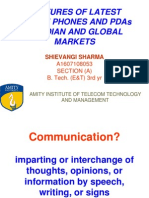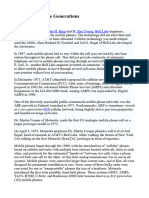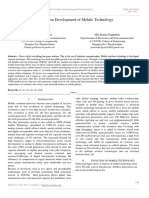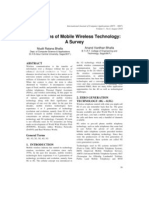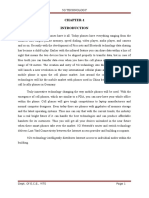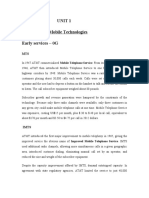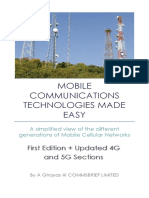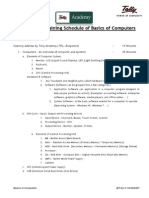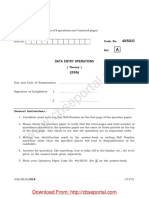Mobile Phones
In early years, mobile phones are supported in only one type of wireless network.
Examples of this are analog or digital. However, most phones today have a dual-mode feature
which supports both digital and analog signals. Some phones even have trimode technology,
which supports analog systems and two digital systems.
Mobile phones are the direct dialing that exists at least since the 1950’s. The so called
two-way radio, also known as mobile rigs that are not mobile phones was used in vehicles such
as taxicabs, fire track, ambulances, private vehicles etc. The users could not easily connect to
the telephone network because the two-way radio or mobile rigs is not yet completely changed
into a real mobile phone. Mobile phones are originally installed in the vehicles until a large
company introduced a so-called transportable or “bag phones” so that they could also be
carried.
It is a portable device powered by batteries also called wireless phone, used for
communication. It may connect via telephone network over radio wave transmission. Mobile
Phones may support games, Bluetooth, short test messaging or SMS and some could access
internet. Mobile Phones can receive radio signals supported by the cell base stations. The most
used data application of a mobile phone is text messaging, voice calls and music. Before, the
only way that supports communication is the Radio Frequency. Radio Frequency transmission
uses radio signals to communicate over long distances using a portion of the frequency
spectrum. Mobile phones use Radio Frequency transmissions. It is used in multiple areas of
wireless communications including network development.
In 1997, One f the large companies establish a satellite network that provides
voice, data, fax and location based-services to its consumer. Handsets are any handheld devices
used to transmit and receive calls from a wireless system. Handsets are commonly referred to
as mobile phones, cell phones or wireless phones. These devices include antennas for signal
transmission, number pads for dialing, speakers and microphones for voice communications,
�operating systems that control how the phones operate and the computer chips needed to
complete wireless communications and other functions.
Voice recognition technology is being developed for computing and wireless devices. An aspect
of voice recognition technology used in some mobile phones is voice-activated dialing, which
allows users to dial a number or check messages on a phone using voice commands. Another
generation of mobile phone, named Telespree, founded in 1999, is developing phones that are
low-cost and require no activation; users do not have to purchase service from a wireless access
service provider to make calls. It also includes a certain number of prepaid minutes.
Personal Digital Assistants are organizer which can store contact information,
appointments, and other personal information by the user. PDAs are equipped with infrared
technology to communicate with the other users and share information with other devices.
Nowadays, Bluetooth wireless technology is now already in used to connect to wireless
networks and transmit information from other devices.
Generations of wireless communications
Technologies are often identified by generations; First Generations (1G), Second
Generations (2G), the intermediate stage between the second and the third generations (2.5G),
Third Generation (3G), and fourth Generation (4G). The technologies become more powerful
every time the sources invent new devices.
First Generation Technology of Mobile Phones
Analog signals are radio transmissions sent in a wave-like form. It is a mobile device that
sends the wave to a base station, where they are processed to determine the signal’s next
destination. Once the destination is determined, the signal is reconstructed as accurately as
possible. The analog signal received by the end user closely resembles the original
transmission, transmission, but rarely duplicates it.
�Second Generation Technology of Mobile Phones
Second-Generation technology of Mobile Phones includes most of the present
technologies and will support many communications system. 2.5G, 3G, and 4G are examples of
second generations of mobile phones. The following sections explore 2G technologies including
Personal Communications Systems (PCS) and Global System for Mobile Communications (GSM).
PCS are designed to use digital-signal transmissions versus 1G analog-signal transmissions.
2.5 Generation and Third Generation technology of Mobile Phones
2.5 generation is the intermediate step between 2G and 3G. It includes networks
transmission speed f approximately 100kbps and supports various data technologies. The Third
generation technology will enable devices to send and receive data as much as seven times
faster than a standard 56kbps modem.
Personal Digital Assistants (PDAs) are organizers that store contact information,
appointments and other persona information. PDAs are equipped with infrared technology to
communicate and share information. Nowadays, mobile phones, PDAs, GPS systems and two-
pagers are already combined, called Convergence devices. Convergence devices offer voice
capabilities, personal organizing, Web browsing, Mp3 audio, short-text messaging and e-mail.
Palm computing was founded as an independent company to produce handheld devices. Palm
computing mission was o create a handheld device that would act as an extension of the
desktop computer, allowing uses to enter a small bi important bits of information while away
from their desks. Communications in network are point-to-point, point-to multipoint and
multipoint-to multipoint. Points refer to the stations, devices or networks sending or receiving
signals. Point-to-point transmission occurs when a network transmits from a central base
station.
In General we shall say that Mobile phone (also called a wireless phone or cellular
phone) is a short-range, portable electronic device used for mobile voice or data
communication over a network of specialized base stations known as cell sites. In addition to
the standard voice function of a telephone, current mobile phones may support many
�additional services, and accessories, such as SMS for text messaging, email, packet switching for
access to the Internet, gaming, Bluetooth, infrared, camera with video recorder and MMS for
sending and receiving photos and video. Most current mobile phones connect to a cellular
network of base stations called Cell Sites, which is in turn interconnected to the Public Switched
Telephone Network (PSTN).
Generations of Mobile Communication
With faster data speeds comes a better service. An example of this is when the
bandwidth reaches a certain threshold, applications and services that transfers real-time audio
and video become possible. The industry goals in wireless data communications have been
categorized into generations– each generation includes a target data bandwidth as well as a set
of data services available for it:
• First Generation (1G):
The network is only capable of transmitting voice via analog signals. The handsets are
big, heavy, and expensive. Those 1G mobile phones are "dumb" voice-only terminals. 1G
networks and mobile phones have been phrased out in most parts of the world. Original analog
mobile phone technology
• Second Generation (2G):
The network uses digital signal to transmit voice. Compared with analog signal, digital
signal is more accurate, reliable, and scalable. As a digital network, the 2G network can carry
text messages along with voice. Those text messages, known as SMS (Short Messaging Service),
are hugely popular. In addition, a 2G mobile phone often integrates a data modem. It can
connect to the internet by making modem calls to certain dial-up service numbers provided by
the carrier. Through the internet, a 2G mobile phone can browse the internet via the WAP
browser software built into the device. Voice-centric digital systems with increased Coverage
and capacity and messaging
�• Third Generation Transitional (2.5G): Stepping stone to 3G with
The network uses a packet-switch infrastructure to provide always-on internet
connections to phones. The data speed in 2.5G network is much faster than that in 2G network.
You do not need to wait for the modem to dial and connect. You are not charged for the air
minutes for the time you spend browsing the internet. Instead, the data traffic is metered by
bandwidth or is simply unmetered with a flat monthly rate. The 2.5G mobile phone supports
data centric applications such as email, MMS (Multimedia Messaging Service), and generic web
browsing. The 2.5G networks and phones are widely deployed in developed countries. always-
on network connections and bandwidths up to 170 Kbps allowing better Internet browsing,
email, and some audio and video; GPRS has been the dominant technology
• Third Generation (3G)/Fourth Generation (4G):
The network provides very fast data access to the phones. You should be able to enjoy
stream audio/video contents on a 3G mobile phone. But the availability of 3G phones and
services is still limited. Bandwidths are up to 2Mbps and 200 Mbps respectively for high-end
services such as video teleconferencing. The topic of wireless communication protocols is vast
and could easily take up another book. But let’s briefly cover some of the key communication
technologies that apply to Smartphones.
General features
Mobile phones are designed to work on cellular networks and contain a standard set of
services that allow phones of different types and in different countries to communicate with
each other.
Before the phone can be used, a subscription to a mobile phone operator (a.k.a. carrier)
is required. For phones on Global System for Mobile (GSM) networks, the operator will issue a
SIM card which contains the unique subscription and authentication parameters for that
customer; alternatively, the carrier will put the customer's handset identifier into its subscriber
database so that the handset can make calls on the network. Once the SIM card is inserted into
the phone, services can be accessed. Many mobile phones support 'auto-roaming', which
�permits the same phone to be used in multiple countries. For this to work, the operators of
both countries must have a roaming agreement.
Mobile phones do not only support voice calls; they can also send and receive data and
faxes (if a computer is attached), send short messages (or "text messages"; see SMS), access
WAP services, and provide full Internet access using technologies such as GPRS. Modern mobile
phones usually have a clock, alarm, and calculator and a few games.
Most current models also allow for sending and receiving pictures and have a built-in
digital camera that can have resolutions as high as 5M pixels, an example of that is Nokia N95.
Sound and video recording is often also possible. This feature is generally referred to as MMS.
This gives rise to some concern about privacy, in view of possible voyeurism, for example in
swimming pools. For this reason, Saudi Arabia has entirely banned the sale of camera phones;
South Korea has ordered manufacturers to ensure that all new handsets emit a beep whenever
a picture is taken.
GPS receivers are starting to appear integrated or connected (i.e. using Bluetooth) to
cell phones, primarily to aid in dispatching emergency responders and road tow truck services.
This feature is generally referred to as E911.
Push to talk, available on some mobile phones, is a feature that allows the user to be
heard only while the talk button is held, similar to a walkie-talkie.
There are also many features aimed toward personalization, such as user defined and
downloadable ring tones and logos, and interchangeable covers, which have helped in the
uptake by the teenage market. Mobile phone content advertising has become massively
popular but has also drawn a great deal of criticism. Usually one can choose between a ring
tone, a vibrating alert, or a combination of both.
As a result of all these features packed into a tiny device, mobile phones have recently
gained reputations for their poor ergonomics. Their small size, plethora of features and modes,
and attempts at stylish design often make them difficult and confusing to use.
�Storage Media
-Svein Y. Willassen Norwegian University of Science and Technology
With the advent of digital mobile telephone systems, such as GSM, a need for local
digital storage emerged. In the GSM system, the single most popular digital mobile phone
system, the SIM (Subscriber Identity Module) was specified as storage medium and
implemented as a smart card that fits inside the phone. The SIM contains subscriber
information and secret encryption keys necessary for the communication. It also implements
storage space for contacts and text messages It is also possible to recover some deleted data
from the SIM (deleted text messages on from some phone models). The SIM architecture is also
used in 3G systems (USIM). However, since the late 1990s, mobile phone manufacturers began
to use mobile phone internal memory in addition to the SIM for storage of information items.
The SIM has a rigorous specification allowing only for certain types of information to be stored.
It does not provide a single continuous memory that can be utilized for any purpose. As the
manufacturers wanted to implement new functions where storage on SIM was not available,
mobile phones were gradually equipped with internal memory for storage of items such as
missed and received calls, calendar events, text messages, contacts and other items. The first
models used a serial EEPROM chip for this purpose. With the growth of memory demand, it
gradually became more common to implement internal memory on flash memory, either as a
flash chip dedicated for information item storage, or as an area on the flash memory chip
storing the phone system software. More recently, with the advent of telephones with cameras
and MP3 players, it has also become common to add possibilities for external flash memory in
mobile telephones. External memory can be added by inserting a memory card such as SD,
MMC, and CF or similar.
Usage of External Memory, Internal Memory and SIM
-Svein Y. Willassen Norwegian University of Science and Technology
In order to understand the value of analyzing mobile phone internal memory, one must
understand where the different information items in mobile phones are stored. In order to
�understand this properly, a range of mobile phones with SIM, internal storage, and to a certain
extent external flash storage was analyzed to determine what information items are stored on
the different media types. The phones were examined by sending and receiving text messages,
taking pictures, store contacts and calendar events, exchanging SIM cards and external memory
cards, and observe the behavior. The results indicate that each manufacturer is consistent in
the way data is handled, but the variation between manufacturers is significant.
Data communications (Mobile Internet)
Mobile phones are now heavily used for data communications such as SMS messages,
browsing mobile web sites, and even streaming audio and video files. The main limiting factors
are the size of the screen, lack of a keyboard, processing power and connection speed. Most
cell phones, which supports data communications, can be used as wireless modems (via cable
or Bluetooth), to connect computer to internet. Such access method is slow and expensive, but
it can be available in very remote areas.
With newer smart phones, screen resolution and processing power has become bigger
and better. Some new phone CPUs run at over 400 MHz. Many complex programs are now
available for the various smart phones, such as Symbian and Windows Mobile.
Connection speed is based on network support. Originally data transfers over GSM
networks were possible only over CSD (circuit switched data), it has bandwidth of 9600 bit/s
and usually is billed by connection time (from network point of view, it does not differ much
from voice call). Later, there were introduced improved version of CSD - HSCSD (high speed
CSD), it could use multiple time slots for downlink, improving speed. Maximum speed for
HSCSD is 42 kbit/s, it also is billed by time. Later was introduced GPRS (general packet radio
service), which operates on completely different principle. It also can use multiple time slots for
transfer, but it does not tie up radio resources, when not transferring data (as opposed to CSD
and like). GPRS usually is prioritized under voice and CSD, so latencies are large and variable.
Later, GPRS was upgraded to EDGE, which differs mainly by radio modulation, squeezing more
data capacity in same radio bandwidth. GPRS and EDGE usually are billed by data traffic volume.
Some phones also feature real keyboards, such as the LG enV.
� As of April 2006, several models, such as the Nokia 6680, support 3G communications.
Such phones have access to the Web via a free download of the Opera web browser. Verizon
Wireless models come with Internet Explorer pre-loaded onto the phone.
Smartphones
A Smartphone is a mobile phone offering advanced capabilities beyond a typical mobile
phone, often with PC-like functionality. There is no industry standard definition of a
Smartphone, For some, a Smartphone is a phone that runs complete operating system software
providing a standardized interface and platform for application developers. For others, a
Smartphone is simply a phone with advanced features.
There is no agreement in the industry about what a Smartphone actually is and
definitions have changed over time. According to David Wood, EVP at Symbian, "Smart phones
differ from ordinary mobile phones in two fundamental ways: how they are built and what they
can do." Other definitions put different stresses on these two factors.
Most devices considered Smartphones today use an identifiable operating system, often
with the ability to add applications (e.g. for enhanced data processing, connectivity or
entertainment) - in contrast to regular phones which only support sandboxed applications (like
Java games) These Smartphone applications may be developed by the manufacturer of the
device, by the network operator or by any other third-party software developer.
In terms of features, most Smartphones support full featured email capabilities with the
functionality of a complete personal organizer. Other functionality might include an additional
interface such as a miniature QWERTY keyboard, a touch screen or a D-pad, a built-in camera,
contact management, an accelerometer, built-in navigation hardware and software, the ability
to read business documents in a variety of formats such as PDF and Microsoft Office, media
software for playing music, browsing photos and viewing video clips, internet browsers or even
just secure access to company mail, such as is provided by a BlackBerry.
The demand for Smartphones software is growing as these device upgrades and become
more powerful and more widely used. Symbian OS is the commonly used software for the
�developers to create new Smartphones since the Smartphones users are always looking for
good applications for their devices. Smartphone is a mobile phone that fits in every users
pocket and lets you communicate from and to anywhere in the world is an amazing invention.
Like most inventions, mobile phones are built on a chain of prior technological advancements.
Without advancements such as integrated circuits and microprocessors the invention of mobile
phones would not be integrated in the world. Smartphones combine the mobile phone with
another stream of technology:
a.) The Computer, which adds the ‘smart’ in smartphone. Computers have progressed
from centralized mainframes to personal computers with user-downloadable
applications and graphical user interfaces.
b.) The Mobile Devices, since the PDA and the mobile phone are both mobile devices,
it’s only natural that we would want to combine them into one device. But a
smartphone is more than just the sum of two devices.
Smart phones use different kinds of operating systems just like computers such as :
Symbian OS from Symbian Ltd.
Symbian has the largest share in most markets worldwide, but lags behind other
companies in the relatively small but highly visible North American market. This matches the
success of its largest shareholder and customer, Nokia, in all markets except Japan. Nokia itself
enjoys 52.9% of the Smartphone market. In Japan Symbian is strong due to a relationship with
NTT DoCoMo, with only one of the 44 Symbian handsets released in Japan coming from Nokia.
It is used by many major handset manufacturers, including BenQ, LG, Motorola, Samsung, and
Sony Ericsson. Various implementations of user interfaces on top of Symbian (most notable
being UIQ and Nokia's own S60) are incompatible, which along with the requirement that
applications running on mobile phones be signed is hindering the potential for a truly widely
accepted mobile application platform. It has received some adverse press attention due to virus
threats (actually trojan horses).
�Windows Mobile from Microsoft
Windows CE operating system along with Windows Mobile middleware is widely spread
in Asia. The two improved variants of this operating system, Windows Mobile 6 Professional
(for touch screen devices) and Windows Mobile 6 Standard were unveiled in February 2007.
Windows Mobile is enjoying great popularity because of the low barrier to entry for third-party
developers to write new applications for the platform.
RIM BlackBerry operating system
This OS is focused on easy operation and was originally designed for business. Recently
it has seen a surge in third-party applications and has been improved to offer full multimedia
support.
iPhone OS from Apple Inc.
The iPhone (and iPod touch) use an operating system called iPhone OS, which is derived
from Mac OS X. Third party applications were originally only made available for iPhone users
through a web service that can be accessed via the included web browser; however, with the
release of iPhone OS 2.0 on July 11th 2008, native applications are now available and can be
downloaded through the iTunes App Store.
Linux operating system
Linux is strongest in China where it is used by Motorola, and in Japan, used by DoCoMo.
Rather than being a platform in its own right, Linux is used as a basis for a number of different
platforms developed by several vendors, including Motorola and TrollTech, which are mostly
incompatible. PalmSource (now Access) is moving towards an interface running on Linux.
Another platform based on Linux is being developed by Motorola, NEC, NTT DoCoMo,
Panasonic, Samsung, and Vodafone.
�Palm OS developed by PalmSource
PalmSource traditionally used its own platform developed by Palm Inc. Access Linux
Platform (ALP) is an improvement that was planned to be launched in the first half of 2007. It
will use technical specifications from the Linux Phone Standards Forum. The Access Linux
Platform will include an emulation layer to support applications developed for Palm-based
devices.
Messages
Base on the purpose of Message Recycler Bin System. The system contains the features
base on the text message system designed for the mobile phone. This system may not relate to
anything regarding the network system of SMS and their feed back since everything is Cell
Phone based, basically it will be the Text Messages portion which consists of Inbox, Outbox,
Draft and Sent Items.
Inbox
It is a storage space where all secure messages appear. New messages are in bold text
until they are viewed by the user. Inbox can also sort according to its expiration date,
alphabetically arranged, by subject or by sender. The user can also sort according to the size of
the message.
Outbox
Outbox is the temporary storage of messages on process of sending before they are
sent. Outbox always retrieve the messages that are not sent due to any sending failures such as
running out of credit, lack of signal and bad respond of Short Message Service Center (SMSC)
which is the network of the Simcard being used in the cell phone. Outbox is originally where
messages live between the time you hit send and the time they are delivered to the receiving
site.
�Drafts
Drafts are seldom used in cell phones. Drafts are also a part of memory where the
Mobile users save either received, composed or sent messages from Text Message System.
Usually drafts are capable of having folders created that may let the user classify the messages
inside the Text Message System.
Sent Items
Sent Items is a part of the memory where all messages that have been sent successfully
from the phone are stored. Messages in Sent Items can always be accessed and forwarded as a
Text Message again as well. Basically Sent Items is the final destination of the sent messages
from Outbox.
Information Retrieval
There is overlap in the usage of the terms data retrieval, document retrieval,
information retrieval, and text retrieval, but each also has its own body of literature, theory,
praxis and technologies. Information Retrieval is interdisciplinary, based on computer science,
mathematics, library science, information science, information architecture, cognitive
psychology, linguistics, statistics and physics.
Enhancement base on the Smartphones Recyclers
Whether you call it trash, garbage, junk, or refuse, it always seems to accumulate —
even on a Mobile phone. Old messages or files take up space on the memory and may make it
difficult to find the ones you really need.
The answer to the trash problem is the Mobile Message Recycler. Whenever you delete
a file, it's sent to the Recycler. You can identify the Recycler from its little icon similar to
windows recycle bin. Some Smartphones introduced it in their operating system and some are
based on windows mobile such as O2 Phones, Palms, Pocket PC and more Smartphones.
� It's easy to delete files and messages that you no longer need, and there are basically
simple ways to delete them:
• Select the file item or message from where it is located, it can be in inbox, folder or even
in sent items and find delete properties in order to delete it;
• Once you received a file that you think you may not even check it, you can just delete it
simply without reading the message or checking the file and it automatically transfers to
the Recycler.
The Recycler is a holding place for deleted files. It's convenient because it's like taking
the garbage to the trash bin outside the house. Deleted files remain in the recycler until it's
emptied. Although you don't usually go rummaging through the trash bin at home, when
working on the computer, there are times when a file is inadvertently deleted and it's nice to
know that you can look through the Recycler to retrieve it.
To retrieve a file from the Recycler, simply open the recycler and you will then see all
files and messages that have been deleted. When you see the file that you want to retrieve
open property menu of the file and choose Restore and the file will return to the place it was
originally stored.
Files remain in the Recycler until you empty it by choosing Empty Recycler from its
properties. For this reason, many users never empty the Recycle Bin, but the data in the
Recycler takes up space on your memory, so you will occasionally empty the trash.
Here are a few other helpful things to know about the Recycler:
• By default, the Recycler is set to reserve up to 10% of your memory space for its use. So
the greater capacity your memory has the lesser volume Recycler would be occupying but if the
memory is small it is advisable to empty the recycler regularly as well.
• Remember that if the Recycler is emptied, items will be permanently deleted rather
than being stored in the recycler.
�Advantages
Prevent Accidental Deletion
Fast and Easy Restore
Flexible Configuration Options
In this case, Recycler users are solely responsible for the restoration process. Users can
perform delete and restores of all soft-deleted messages and files.










